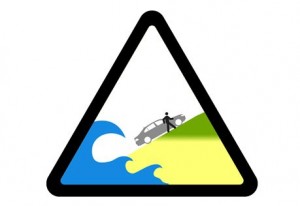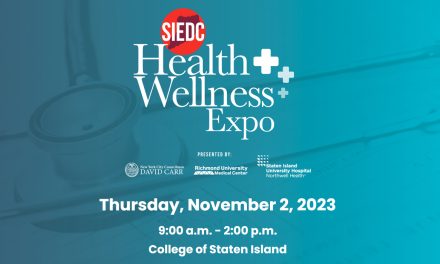
Education is a key component of Dr. Fritz's plans for a post-Sandy Staten Island. At the conference, he unveiled a prototype graphic that could be used in vulnerable coastal areas to reinforce the necessary "climb to safety" response to impending storm surges.
STATEN ISLAND ADVANCE — How to rebuild smarter — and at one with nature — in post-Sandy Staten Island drew hundreds to a day-long symposium here Friday, as the borough continues to grapple with the devastation wrought by last October’s killer hurricane.
Academics and government officials headlined panel discussions at the College of Staten Island, resulting in some very clear take-aways: Portions of the East and South Shores swamped by Sandy should be returned to Mother Nature and not rebuilt; the city’s 911 system needs an overall [sic], after trapped Islanders desperate for help resorted to contacting their elected officials via Facebook; the mental health traumas of the storm continue to linger; and the disabled and elderly were left to fend for themselves, with some tragic consequences.
“Our Sandy occurred in 1953,” said Dutch official Arjun Braamskamp of the North Sea Flood, which forced his nation into a decades-long effort to stave off such devastation again. Part of that included passage of the Delta Act, which mandates that the Netherlands maintain its coastline, regardless of politics and budgetary constraints.
“Building with nature makes better economic sense and better environmental sense,” said Braamskamp in urging decision-makers to incorporate nature into redesign plans instead of devising ways to keep water out.
Building barriers along the entire coastline isn’t practical, said Braamskamp, an economic officer at the Netherlands Consulate General in New York. Rather, “working as one with the environment” and creating overlapping layers of defense, such as levees, sand, dune and salt marsh reinforcement, a lock system employed during major storm events and incorporating water retention areas such as underground parking garages for an integrated approach.
“We had to acknowledge that as sea levels continue to rise, we needed to come up with a smarter plan,” said Braamskamp. “We had to allow the water to come in whenever possible.”
Geologist Dr. William Fritz, CSI’s interim president, offered up several points to protect Staten Island from future storm surges — including an “education” component of simple signage clearly outlining evacuation options to save lives.
Along those lines, City Councilman James Oddo (R-Mid-Island/Brooklyn) said more should have been done to reach out to seniors who felt stranded, and in some cases perished. He also highlighted the need for the borough “to get our fair share” of federal storm dollars.
Assemblywoman Nicole Malliotakis (R-East Shore/Brooklyn) expressed frustration that various levels of government have not presented a coordinated approach in terms of buyout options and storm mitigation rules for rebuilding, leaving homeowners at a loss as how to proceed.
She also addressed the importance of generators at gas stations and policies to better protect insurance consumers.
Seth Pinsky, president of the city’s Economic Development Council, and head of the mayor’s Special Initiative for Rebuilding and Resiliency, said the Island’s housing stock and topography left residents “not aware of how vulnerable they were.”
Looking at the tragedy from a social science perspective, CSI Professors Lacey Sloan and Katie Cumiskey discussed the lack of coordination among non-profit organizations in Sandy’s aftermath, and how many residents continue to struggle emotionally.
Another panelist, graduate student MaryBeth Melendez, who is visually impaired, spoke of the hardships she and other disabled individuals faced with evacuation and transportation options. She said Access-A-Ride shut down two days before Sandy hit.
Meanwhile, FEMA official Michael Klitzke said residents should evacuate when told to do so.
“Know your risk; know your role,” advised Klitzke. “Just because you want to ride it out because it’s never flooded here before, don’t. Go.”
This article was written by Judy L. Randall with the Staten Island Advance and first appeared on www.silive.com on March 08, 2013 and was updated March 09, 2013 at 6:58 AM. It is reprinted here with permission.
Read “The Toll” from The New Yorker magazine, featuring Dr. William J. Fritz and highlighting the College of Staten Island and Hurricane Sandy.
















